The photo that I am going to be analysing is ‘Peanuts’ by Chris Wimpey. This photo was used as an advertising campaign for four 2002 Harley Davidson Bikes. This being one of three adverts used. The analysis I am going to use is semiotic with comparison when it is required to do so. So that I can compare the ‘Peanuts’ advert with the other 3 with in the series. To help me with the analysis I have used the questions from Gillian Rose on how to interpret a photograph. Interpretations is described by Barret, T very well in ‘Criticizing Photographs’ “To Interpret is to account for all the described aspects as a photograph and to posit meaningful relationships between the aspects.” (Barrett, T. (2000) (3rd ed). Criticizing photographs pg37). I will use this definition to help me analyse this photo and decide whether it was a good photo for this advertising campaign or not.
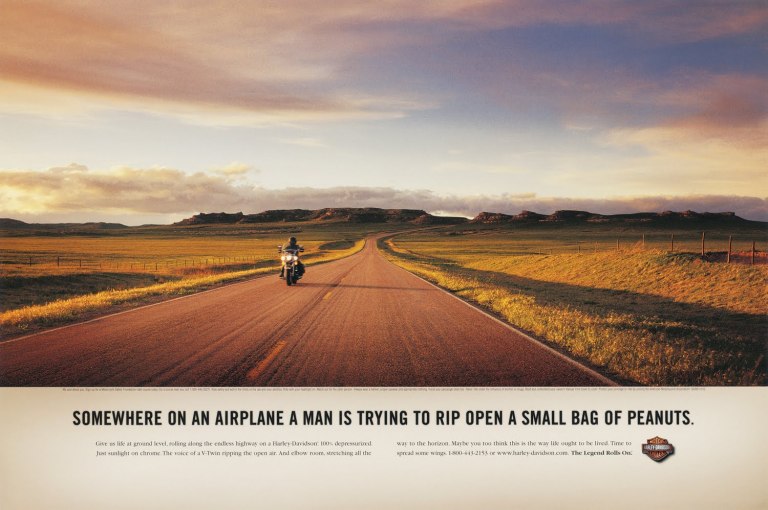
This advert collection was specifically designed to be put in to a motorbike magazine. This puts the audience above the age of 18 because that’s at the age you can ride a bike with a bigger engine, it’s also a predominantly male audience. It is easy to tell that the advert is for magazine because it is landscape but also because Wimpey has used the rule of thirds which keeps the bike away from the staples so it wont become distorted. Seeing as the motorbike advertised is the Harley Davidson FLHR Road King which is designed as a traveling cruising bike comfortable for long journeys and that is part of the audience’s idea of a good life the idea of an adventure. This advert was also released during January 2002 just after the terrorist attack of the World Trade Centre Buildings commonly known as 9/11, they play off this fear of flying to persuade people to buy the bike. Walter Davidson who helped fund and make the first Harley Davidson wanted a bike that could go anywhere and do anything. This shows in the movement within the photo but also within the complete collection of the adverts.
This advert certainly within the collection reverses the idea of danger. In reality traveling by motorbike is one of the most dangerous ways of traveling compared to airplanes which are one of the safest ways to travel but due to the terrorist attacks of that time it made staying on the ground seem safer than being in the sky. This is still seen to some extent in todays culture where there has been an increasing amount of incidents on planes be it actually attacks or problems with the planes. The tag line of “Somewhere on an airplane a man is trying to rip open a small bag of Peanuts.” Makes it sound small and confined while the photo shows the complete opposite of rolling landscape, the ability to see the horizon line and the twisting road leading in to the distance. The photo paints a story of taking time, visiting far off places, doing things at a pace that suits the rider and seeing places only a handful of people have seen before. This is a complete opposite of the idea of sitting in a metal tube and getting there as quickly as possible with no stops in-between. It makes the onlooker think about the opposition seen between people who sit behind a desk all day and those who have a full life of enjoyment. Playing on that fear of flight though slightly insensitive was a good move in an advertising sense. During 2001 Harley Davidson sold 3407 bikes that increased in 2002 up 4091 due to this ad campaign and possible fall out from the terrorist attack. (https://www.statista.com/statistics/267311/worldwide-motorcycle-revenue-of-harley-davidson/, accessed 14th December 2016)
‘Peanuts’ is one in four photos done by Chris Wimpey for the Harley Davidson ‘The Legend rolls on’ the fact that it is one of four helps anchor it as an American dream and a traveling adventure especially being able to see different bikes in different locations around America as a group they give the message of “look what you can see if you use our bike,” old American style diners, amazing rock faces, open roads.
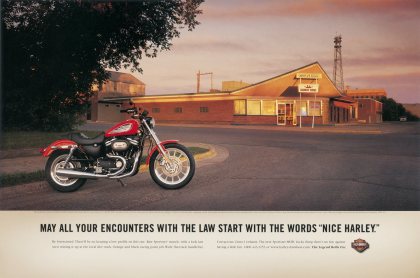
It gives a sense of American Greatness and the perceived American dream of road tripping across the country. This is emphasised in the last line on the peanut advert “Time to spread some wings.” This gives a nod to the bald eagle which is the sign of America and the freedom people see in America. Which is the basis of the whole campaign this freedom to go anywhere and do anything. There are songs about rolling down the American highways and the exhilarating freedom it brings which can be fully seen in these images. Chris Wimpey does a majority of out door advertising photography for sports company’s and biking company’s all of which show a sense of freedom and the ability to see amazing places. The difference between ‘Peanuts’ and the other photos in the campaign is that it’s the only one with a human in it and the only one where the motorbike is moving. This gives it more of an appeal compared to the others due to the fact that it doesn’t look like an advertising campaign. It looks like it’s from a movie with this cinematic look to it with the soft inviting light in the sky. A more of a “if you buy a Harley then this is the experience you can get.” It’s selling the experience of the bike instead of just the bike. The fact that the bike isn’t fully in focus gives the sense of movement but it also helps push the experience by letting the viewer explore the photo without being drawn to the bike instantly. Compared with Wimpey’s other adverts this is very much inline with what he does, he tries to sell the experience not just the product which makes for some beautiful imagery rather than just another advert.
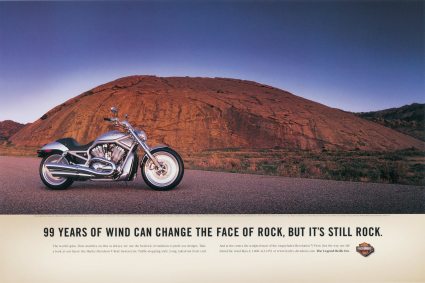 The first thing the viewer notices is how beautiful the imagery is. How warm it looks and how inviting it seems. Seeing as its a dream a majority of motorbike riders share of riding across country it helps that it was included in motorbike magazines because looking at that photo makes the onlooker think to themselves about the dream and how they want to be there. It almost makes the song ‘On Days like these’ by Matt Monroe play in the viewer’s head, similar to in the 1969 original movie ‘The Italian Job’ where in the opening scene a convertible slips and glides around the bends overlooking a picturesque gorge in Italy. The ultimate engine head’s dream. The choice of this road, possibly Route 66, helps push that idea of adventure. It is not until the viewer has taken in the obvious beauty of the image they notice the tag line and text.
The first thing the viewer notices is how beautiful the imagery is. How warm it looks and how inviting it seems. Seeing as its a dream a majority of motorbike riders share of riding across country it helps that it was included in motorbike magazines because looking at that photo makes the onlooker think to themselves about the dream and how they want to be there. It almost makes the song ‘On Days like these’ by Matt Monroe play in the viewer’s head, similar to in the 1969 original movie ‘The Italian Job’ where in the opening scene a convertible slips and glides around the bends overlooking a picturesque gorge in Italy. The ultimate engine head’s dream. The choice of this road, possibly Route 66, helps push that idea of adventure. It is not until the viewer has taken in the obvious beauty of the image they notice the tag line and text.
The tag line helps push home what the image is portraying of the ultimate adventure. 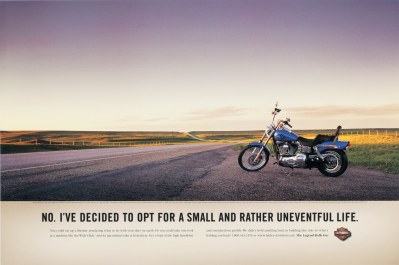 With the punctum giving a hard hit at the idea of flying across country. It is commonly believed that it isn’t about the destination it’s about the journey you take to get there. No border control, no security, no stress. In the tag line is something that anyone who has flown on a plane can understand “trying to rip open a small bag of Peanuts,” reminds the viewer of the stress of being on the plane, the frustration of trying to open food and not getting on the people sat with you, the money grabbing of the airlines for only providing a small bag meaning you will get hungry quicker making you buy more. This really helps push the idea of the fact that you have the freedom to stop and eat as much as you want when you want, you won’t get stressed. A key fact is that the road is completely empty except for the Harley Davidson which shows no hold ups, no cues, total freedom. The fact that you share the experience of the plane with several hundred others while the open road is all yours.
With the punctum giving a hard hit at the idea of flying across country. It is commonly believed that it isn’t about the destination it’s about the journey you take to get there. No border control, no security, no stress. In the tag line is something that anyone who has flown on a plane can understand “trying to rip open a small bag of Peanuts,” reminds the viewer of the stress of being on the plane, the frustration of trying to open food and not getting on the people sat with you, the money grabbing of the airlines for only providing a small bag meaning you will get hungry quicker making you buy more. This really helps push the idea of the fact that you have the freedom to stop and eat as much as you want when you want, you won’t get stressed. A key fact is that the road is completely empty except for the Harley Davidson which shows no hold ups, no cues, total freedom. The fact that you share the experience of the plane with several hundred others while the open road is all yours.
The complete tag line reads:
“Somewhere on an airplane a man is trying to rip open a small bag of Peanuts.
Give us life at ground level, rolling along the endless highway on a Harley-Davidson: 100% depressurized. Just sunlight on chrome. The voice of the v-twin ripping the open air. And elbow room stretching all the way to the horizon. Maybe you too think this is the way life ought to be lived. Time to spread some wings… The Legend Rolls On.”
Which is held in a cream rectangle below the open golden photo. This denotes a comparison between the riding on a bike and flying in a plane, the fact that the text is held in a rectangle seems to be just to help the words stand out but it connotes this division between people who want to take a flight and get to the place as soon as possible and people who want an adventure, a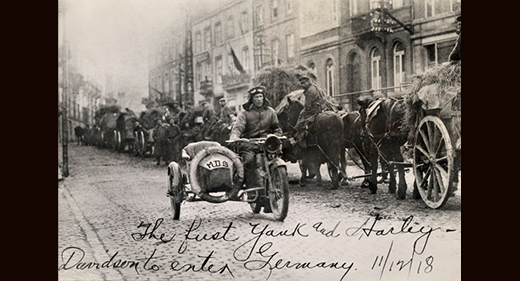 faceless person on a plane and a companion on the road. Though it is linked, without the photo you still get the message, without the text you can still understand the message. That is why I believe the rectangle is cream and not white, if it was white it would connote a complete division and there would be no subtle link, the off white links in with the highlight in the clouds. It also helps link between the other photos in the collection. All the photos have a warmth in the light to them this is a very inviting feeling but if you tie it with the tag line on all the photos of “The Legend Rolls On.” It makes the onlooker think about the age of the company 114 years of making motorbikes to a high standard and they are still producing them. Part of the reason they remained a legend was because during World War One Harley Davidson and Indian Motorbikes both teamed up with the USA Military to supply to the troops the difference was that Harley offered to teach all military personal how to fix the Harley’s. Meaning that once the war was over they had a fan base of military men who knew how to fix the bikes, so would want the bikes but could also go in to the factories and get back to work. Though the amazing part was that the first known photo of the Yanks to enter Germany was of them on a Harley-Davidson. This cemented them as part of history. This helps in the new advert because it’s meant to show that you can go anywhere and do anything and that like back then you can fix it yourself, you don’t need to wait for backup. (https://www.harley-davidson.com/content/h-d/en_US/home/museum/explore/hd-history/1910.html)
faceless person on a plane and a companion on the road. Though it is linked, without the photo you still get the message, without the text you can still understand the message. That is why I believe the rectangle is cream and not white, if it was white it would connote a complete division and there would be no subtle link, the off white links in with the highlight in the clouds. It also helps link between the other photos in the collection. All the photos have a warmth in the light to them this is a very inviting feeling but if you tie it with the tag line on all the photos of “The Legend Rolls On.” It makes the onlooker think about the age of the company 114 years of making motorbikes to a high standard and they are still producing them. Part of the reason they remained a legend was because during World War One Harley Davidson and Indian Motorbikes both teamed up with the USA Military to supply to the troops the difference was that Harley offered to teach all military personal how to fix the Harley’s. Meaning that once the war was over they had a fan base of military men who knew how to fix the bikes, so would want the bikes but could also go in to the factories and get back to work. Though the amazing part was that the first known photo of the Yanks to enter Germany was of them on a Harley-Davidson. This cemented them as part of history. This helps in the new advert because it’s meant to show that you can go anywhere and do anything and that like back then you can fix it yourself, you don’t need to wait for backup. (https://www.harley-davidson.com/content/h-d/en_US/home/museum/explore/hd-history/1910.html)
The fact that the Harley-Davidson in the advert is slightly out of focus shows that it’s going fast but it also serves another purpose. Harley-Davidsons have a distinct shape so this is showing that it doesn’t have to be the Harley Davidson FHLR Road King, that they are trying to sell, but you can use any of the Harley Davidson bikes, they will all get you where you want to go.
In conclusion I believe that ‘Peanuts’ by Chris Wimpey is a successful photograph and delivers the message across with great joy and tenderness, all of the elements come together well to help sell the whole ethos and history of Harley-Davidson. It was quite successful in America as this collection won a Kelly award in 2002 which is a set of awards for advertising. Chris Wimpey worked with advertising company Carmichael Lynch for this campaign which lead to the winning of this award. Carmichael Lynch have gone on to win another award to 2004 for Harley Davidson again. The reason I personally see it as successful photo is due to how inviting it seems and how the winding road leads the viewer in to this serene dream world where everything is perfect and I think the tag line really helps paint that perfect picture.
| Bibliography |
| Barrett, T. (2000) (3rd ed). Criticizing photographs pg37 |
| Harley and The Davidsons part 1, 2 and 3 Discovery Channel |
| Harley Davidson Statistics https://www.statista.com/statistics/267311/worldwide-motorcycle-revenue-of-harley-davidson/, accessed 14th December 2016 |
| Photos: http://chriswimpey.blogspot.co.uk/2011/05/harley-davidson-for-carmichael-lynch.html
Accessed 10th December 2016 |
| Rose, G, 2001 Visual Methodologies: An Introduction to the Interpretation of Visual Materials. London |
|
Word War 1 photo: https://www.harley-davidson.com/content/h-d/en_US/home/museum/explore/hd-history/1910.html accessed 8th January 2017
|